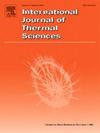Numerical and experimental evaluation of temperature field and melt flow in keyhole laser welding of dissimilar duplex stainless steel and nickel base alloy
IF 4.9
2区 工程技术
Q1 ENGINEERING, MECHANICAL
International Journal of Thermal Sciences
Pub Date : 2025-03-17
DOI:10.1016/j.ijthermalsci.2025.109858
引用次数: 0
Abstract
To achieve high quality joint in keyhole laser welding of two dissimilar metals, phase transition behavior, the temperature and velocity field according to the variation of the process parameters were evaluated by utilizing both experimental and numerical approach. Due to the existing complex phenomena, the comprehensive analysis of the weld geometry and temperature field dependency in keyhole formation was performed either numerically or experimentally. An accurate numerical simulation of temperature and velocity fields, as well as material phase change at circular geometry path of laser beam movement were analyzed on dissimilar metals of duplex 2205 stainless steel and AISI 685 alloy metals to estimate such mentioned phenomena that could not be merely evaluated via experiments. A multi-physics numerical model that employed the finite volume method (FVM) and volume of fluid method (VOF) was utilized. The major novelty of dissimilar circular weld joint was simultaneous estimation the effect of different size and thereby volume of AISI 685 alloy and duplex 2205 alloy on the parts heat sink capacity, temperature gradient, melting ratio, fusion zone microstructure and fusion zone melt volume. The main reason for this is the asymmetric temperature distribution, resulting from the combined effects of material properties and the differing geometries and material volumes of the welded parts. To distinguish the laser process parameters, impact on the weld characterization according to the numerical simulation, the findings demonstrated that increasing the speed of the laser beam leads to the formation of bulge on the part's surface and around the keyhole while simultaneously diminishing the vapor volume. Furthermore, the laser beam's deviation from −0.25 mm at the AISI 685 alloy sheet to +0.25 at duplex 2205 led to the temperature reduction up to 300 °C at 1 mm distance from the joint centerline. Comparing the weld bead geometrical changes according to the variation of laser power and welding speed implies that the predicted temperature field of numerical simulation results is in good agreement with experimental results of weld bead geometry. The maximum error for experimental temperature measurement according to the variation of welding speed and laser power was less than 3 percent. By increasing laser power from 300 to 400 W, not only has the weld bead width become twofold, but also it penetrated toward the thickness completely, and the amount of weld bead overlap evidently increased more than 40 percent. The dissimilar joint fusion zone is mainly composed of cellular and columnar dendrite microstructure mainly created from nickel base alloy solidification according to the rapid heating followed by fast cooling induced by laser heating during welding.
为了在两种异种金属的锁孔激光焊接中实现高质量的接头,我们利用实验和数值方法对相变行为、温度场和速度场随工艺参数变化的情况进行了评估。由于存在复杂的现象,对焊接几何形状和锁孔形成过程中的温度场依赖性进行了数值或实验综合分析。针对双相 2205 不锈钢和 AISI 685 合金等异种金属,对激光束运动的圆形几何路径上的温度场、速度场以及材料相变进行了精确的数值模拟分析,以估计上述无法通过实验进行评估的现象。研究采用了有限体积法(FVM)和流体体积法(VOF)的多物理场数值模型。异种圆形焊接接头的主要创新点是同时估算了 AISI 685 合金和双相 2205 合金的不同尺寸和体积对零件散热能力、温度梯度、熔化率、熔合区微观结构和熔合区熔体体积的影响。造成这种情况的主要原因是材料特性和焊接零件的不同几何形状和材料体积的综合影响导致温度分布不对称。为了根据数值模拟来区分激光工艺参数对焊接特征的影响,研究结果表明,提高激光束的速度会导致在零件表面和锁孔周围形成隆起,同时减少蒸汽体积。此外,激光束的偏差从 AISI 685 合金板材的 -0.25 mm 到双相 2205 的 +0.25 mm,导致距离接头中心线 1 mm 处的温度降低到 300 °C。比较焊缝几何形状随激光功率和焊接速度的变化而变化的情况表明,数值模拟结果预测的温度场与焊缝几何形状的实验结果非常吻合。根据焊接速度和激光功率的变化,实验温度测量的最大误差小于 3%。激光功率从 300 W 增加到 400 W 后,焊缝宽度不仅增加了一倍,而且完全向厚度方向渗透,焊缝重叠量明显增加了 40% 以上。异种接头熔合区主要由蜂窝状和柱状树枝状微观结构组成,这些微观结构主要由焊接过程中激光加热引起的快速加热和快速冷却在镍基合金凝固过程中产生的。
本文章由计算机程序翻译,如有差异,请以英文原文为准。
求助全文
约1分钟内获得全文
求助全文
来源期刊

International Journal of Thermal Sciences
工程技术-工程:机械
CiteScore
8.10
自引率
11.10%
发文量
531
审稿时长
55 days
期刊介绍:
The International Journal of Thermal Sciences is a journal devoted to the publication of fundamental studies on the physics of transfer processes in general, with an emphasis on thermal aspects and also applied research on various processes, energy systems and the environment. Articles are published in English and French, and are subject to peer review.
The fundamental subjects considered within the scope of the journal are:
* Heat and relevant mass transfer at all scales (nano, micro and macro) and in all types of material (heterogeneous, composites, biological,...) and fluid flow
* Forced, natural or mixed convection in reactive or non-reactive media
* Single or multi–phase fluid flow with or without phase change
* Near–and far–field radiative heat transfer
* Combined modes of heat transfer in complex systems (for example, plasmas, biological, geological,...)
* Multiscale modelling
The applied research topics include:
* Heat exchangers, heat pipes, cooling processes
* Transport phenomena taking place in industrial processes (chemical, food and agricultural, metallurgical, space and aeronautical, automobile industries)
* Nano–and micro–technology for energy, space, biosystems and devices
* Heat transport analysis in advanced systems
* Impact of energy–related processes on environment, and emerging energy systems
The study of thermophysical properties of materials and fluids, thermal measurement techniques, inverse methods, and the developments of experimental methods are within the scope of the International Journal of Thermal Sciences which also covers the modelling, and numerical methods applied to thermal transfer.
 求助内容:
求助内容: 应助结果提醒方式:
应助结果提醒方式:


